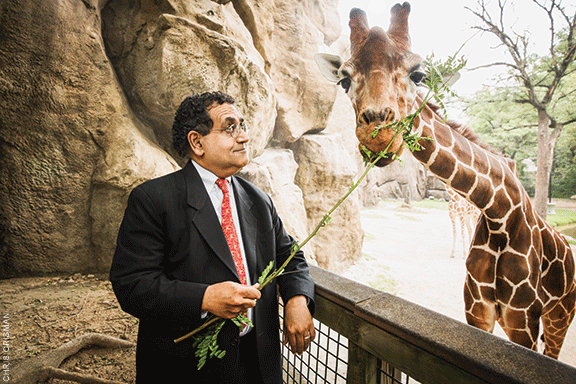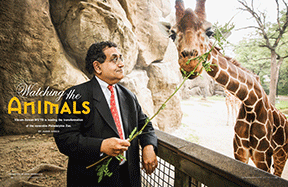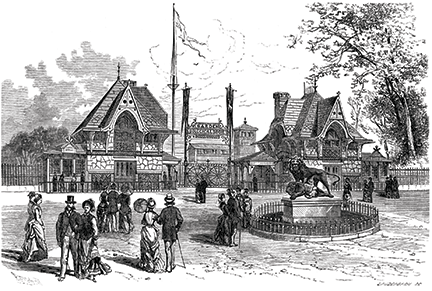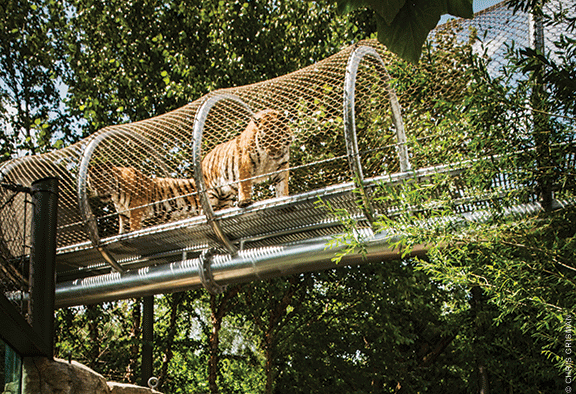
Vikram Dewan WG’78 is leading the transformation of the venerable Philadelphia Zoo.
BY JOANN GRECO | Photography by Chris Crisman C’03

Vikram Dewan WG’78 is sitting at a table in a shaded area of the Philadelphia Zoo, watching a Canada goose waddle its way around the seating area. Eventually the goose extends its neck upwards for a better look.
“It wants to know what’s going on,” Dewan says. “I’m aware that I should try to stay away from terms like wants to, but I recognize that watching animals helps us understand our place as human beings and puts us on a path to empathy.”
Dewan, the 60-year-old president and CEO of the venerable zoo, also listens to animals, a trait that becomes clear when he talks about Tony, a Southern white rhinoceros. “He’s very docile, and loves to get his belly rubbed,” he says. “I frequently turn to him for advice. He recognizes my voice; he responds.” (Kira, a female Amur tiger, on the other hand, is “very good at ignoring me,” he says with a sort of rueful admiration. “It’s no surprise, I guess, that I absolutely adore her.”)
Dewan pays considerable attention to the zoo’s two-legged animals as well. He adheres to the credo of Management By Walking Around, chatting up members of the 400-person staff and asking questions of hundreds of interns and volunteers. Having worked in human resources for Wachovia Bank before becoming a regional president, he understands that, in a service business, interactions with people are key.
“Within a much smaller organization, it becomes that much more important,” he says. “I’m surprised, actually, by how much people are willing to share—and a lot of it is good. I try to carve out at least an hour a day to be a part of that. Some days, it’s much more—I might spend the whole day out there.”
Dewan is short and stocky, with curly dark hair, and round glasses. Not for him the khaki shorts and T-shirts of most zoo personnel; even on a hot day, he’s likely to be found wearing a white shirt, gray slacks, and black loafers. His manner is deliberate—he never loses track of a question’s multiple prongs—but enthusiastic, his voice rising as he reflects on an environment, and a set of duties, he clearly loves. The opportunity to metaphorically talk to the animals, he adds, makes his the “best job in the world.”
He’s held it since 2006, managing a $25 million operating budget in such a way that the zoo’s 1,300 animals—and its 1.27 million visitors each year—are a happy lot. At the same time, he’s overseeing a series of capital projects that are transforming America’s oldest zoo—which opened in 1874 on property once owned by William Penn’s grandson, John—into, arguably, its newest. The last five years have seen a new avian center, a new parking structure, a new children’s zoo, and, most notably, the inauguration of an ambitious system, called Zoo360, of metal mesh-covered, tube-like “trails” that swoop through the property both overhead and on the ground, connecting habitats of varied species. By allowing animals to experience, and share, environments outside of their normal habitats, the trails also give the zoo—hemmed in by West Philadelphia neighborhoods and Fairmount Park and confined to the same 42 acres it’s always had—an opportunity to make the most of its limited space.
In his 1977 essay “Why Look at Animals?” John Berger sounded a rallying cry for a kind of anti-zooism that still reverberates, albeit to a lesser degree than it once did. “Adults take children to the zoo to show them the originals” of their toy animals, he carped. Once there, he continued, the animals seem “lethargic and dull … isolated from each other and without interaction between species.” But anyone who’s been to a zoo in the last decade or two knows that things have changed dramatically since then—and, in some places, had already been changing for some time. New York’s celebrated, 265-acre Bronx Zoo opened its first outdoor enclosure, African Plains, in 1940. Though it took others a while to catch up, a rough trajectory of zoo history has them shifting from collections assembled simply for the watching of wild animals to organizations with a mission to watch out for them. In this model, the zoo became a vehicle for education and conservation. (Significantly, the Bronx Zoo’s manager, the New York Zoological Society, re-named itself the Wildlife Conservation Society in 1993.)

Next, the art and science of behavioral enrichment emerged, based on a new understanding that captive animals not only deserved bigger and more realistic renditions of their natural habitats but that they would benefit from certain stimuli—such as toys, ropes and pulls, the chance to hunt for hidden food, and piped-in acoustics that mimic the sounds of prey. Lately, the focus is once again on their environments, with a goal of not just helping them get more exercise and experience a greater variety of sights, smells, and sounds (including those of their potential prey or predators) but also of giving them the chance to make choices.
“The idea of rotating zoo animals in and out of spaces is not brand new,” says Andrew Baker, a zoologist who’s been at the Philadelphia Zoo for 22 years and is now its chief operating officer. “The Atlanta Zoo has a facility along those lines for gorillas, and in Louisville an exhibit called Islands features multiple species, including orangutans, Sumatran tigers, and wild pigs, found in places like Indonesia.
“Allowing animals to travel has been done before, too,” Baker continues. “The poster child for that is the National Zoo’s Orangutan Transportation System—the so-called “O Line”— which was ground-breaking. It allows the orangutan to swing on an overhead suspended cable from the great ape house down to a space they call the Think Tank, an exhibit that examines animal cognition.”
What no other zoo has done before, though, says Baker, is “put these two pieces together—animal rotation, which is often likened to time-sharing, and animal travel. Plus, we’re blowing the ideas up, campus-wide.”
The system emerging at the Philadelphia Zoo has been unveiling itself in stages, year by year. First came the Treetop Trail, for small arboreal species like blue-eyed lemurs, which opened near the main entrance in 2011 and was expanded in 2013 to stretch toward the new children’s zoo; it now spans a total of 1,735 feet. In 2012, the 200-foot Great Ape Trail opened, giving orangutans and gibbons roaming privileges. This summer, the 330-foot Big Cat Crossing emerged, showcasing tigers and leopards and jaguars in all of their magnificence.
Next year plans call for fine-tuning and expanding all three trails. The Great Ape Trail will grow, permitting gorillas to enter the picture; the ground portion of the Big Cat trail will expand so that it takes the felines alongside Bird Lake and parallels the Great Ape Trail overhead; and a fairly short but critical extension of the Treetop Trail will connect small primates to the Great Ape portion.
The following year promises to introduce the pilot phase for a ground-level trail that will see zebras, rhinos, giraffes, hippos, and other large, hoofed stock walking (not necessarily at the same time) past zoo-goers in the manner of a train at a railroad crossing. By the end of the decade, most of the mammal collection will tie into the trail system, with the area vacated by the old children’s zoo to serve as a central meeting space, “literally a watering hole,” as Baker notes.
So far, there have been some surprises.
“We initially thought the trails would be a way to get animals from one place to another, but now we’re seeing that they view them as habitats in their own right,” Baker observes. “Whether it’s temperature or other conditions, they’re deciding, ‘This is where I want to rest or spend some time.’”
The behavioral opportunities those trails provide are “pretty profound,” he continues. “The company you keep is no longer defined by the enclosure. I don’t want to ascribe motivations, but we see this happening over and over again. It’s pretty fun to watch.”
Within the next year or so, Baker adds, the zoo will more formally study and measure this usage and will apply cognitive bias testing, which comes out of human psychology, to measure mental-health traits (such as optimism) in animals that have participated in the trail network.
The projects are all part of a 10-year master plan that the zoo adopted in 2010 to guide its physical development. The plan was formulated with Philadelphia’s CLR Design, which has a long history of creating pioneering zoo exhibits (including the Philadelphia Zoo’s PECO Primate Reserve), and Jon Coe, a co-founder of that firm who has since left to start his own consultancy in Australia. It builds on an earlier exhibit, First Niagara Big Cat Falls, which uses short bridges and tunnels to link outdoor enclosures and an indoor education center so that the six species can visit each other’s habitats. The $20 million exhibit opened in 2006 and won an award from the Association of Zoos & Aquariums.
“Vik’s arrival dovetailed nicely with that opening, which had been in the works for a while,” says Baker, whose first gig at the zoo was as its curator of mammals. “I was part of the selection committee that chose him and was impressed by his commitment to the zoo becoming the best in the world. We had been doing good work over the past 20 years, but he had very exciting and energizing ideas about enlivening the guest experience while forwarding our mission to create the best environment for the animals in our collection.”
While Dewan has been an avid student of zoo trends, he is neither an animal behaviorist nor an exhibit designer. True, he owns a brood of eight cocker spaniels and fondly remembers taking his kids to the zoo. But his familiarity with animals was likely at the bottom of the checklist when the zoo’s board selected him to replace its long-time leader, Alexander “Pete” Hoskins, who at least had an extensive record of public service, including posts at the city’s Streets Department and Fairmount Park Commission. By choosing a career finance guy who knew how to read a spreadsheet but had no idea how to spread hay, the 32-member board took a leap that raised eyebrows.
It was love that first brought Dewan to Philadelphia.
“My wife grew up in Pennsylvania, and we picked our graduate schools together,” he explains. (He was born in Iran to Indian parents and came to the States to attend Cornell University, where he studied economics and government.) “Jami selected Temple, and I chose Wharton. I was looking for the school that would best allow me to put together a program to study finance with a bent toward community service.”
The pull of finance led him to a long stint in banking. One of Wachovia’s clients was the Philadelphia Zoo, and when the position of president opened, several members of the zoo’s board recommended Dewan as a qualified candidate.
“The board was looking for a different approach,” he says. “It was apparent that its model wasn’t sustainable—it needed a long-term financial strategy. There was a book out around the time, one of those management-guru titles, called Blue Ocean Strategy. Basically, it suggested that the organization that opts to do things differently than expected can do really well.”
Faced with significant shortfalls for planned projects, the zoo’s leaders didn’t need much convincing.
“We have some of the best zookeepers, some of the best educators in the world,” board chairman Peter Gould told The Philadelphia Inquirerin announcing Dewan’s hiring. “We didn’t feel like we had to reach out into the community for that set of skills. We needed all the others.” It wasn’t long before other zoos, such as Zoo Atlanta and the Houston Zoo, began opening their doors to chief executives with successful careers in the financial world.
Once on board, Dewan proposed a path to financial sustainability that emphasized looking further ahead and building on success.
“What typically happens for most zoos, and we were no exception, is that they build, say, a $20 million exhibit that generates a lot of excitement and then attendance spikes and everyone’s happy,” he explains. “After a year or two, the levels go back down. This saw-toothing hinders you from making further investments, since you can’t reliably predict revenues. Plus, you find yourself lacking the resources to maintain the mega-exhibits you’ve created.”
One way the zoo is keeping attendance on an even keel, he says, is by extending its “high season” beyond the traditional Memorial Day-to-Labor Day and adding two months on either end. (It is, of course, open in the dead of winter, too.) In fact, thanks to revved-up marketing, new indoor exhibits, and increased programming related to the zoo’s pet environmental projects (including water conservation and protecting orangutan habitats from deforestation by pushing for a sustainable palm-oil industry), the busiest month for the last few years has been April.
The numbers are encouraging in other ways as well. Faced with a peak debt of $21.5 million when he arrived, Dewan and the board began an aggressive program to reduce it while at the same time increasing the endowment. The successes weren’t as quick and hearty as a strategic plan called for—the economic downturn of 2008-2009 got in the way—but by 2012, the debt had been cut by 21 percent, the endowment boosted by 16 percent, and the annual draw from that endowment was down to four percent, a figure that put the zoo in alignment with not-for-profit best practices.
Endowments and major donors (the zoo receives no operating funding from the cash-strapped city) both help, says Dewan, but it’s critical that visitors continue to stream in—and come back often.
“The family who spends $120 for a household membership is our primary driver,” he says. “Everything we do revolves around keeping them engaged and delivering meaningful experiences.
“I love watching our guests,” he continues, pointing to a woman near the swan boats as she takes a selfie with her son, who’s just had his face painted. “They’re creating memories. The zoo appeals to every facet of the greater Philadelphia community, and to be involved in an organization that reaches out to so many—and so many diverse—people has tremendous resonance for me. Around the time I learned about this job, I had been thinking a lot about how and where I could make the best contribution. Seeing the zoo at such an interesting crossroads in 2006, it seemed that I could offer a lot.”
It offered some benefits to Dewan as well. “I rock at my grandkids’ show-and-tell,” he says. “I can definitely deliver in the very competitive world of grandparents.
“But in many ways, this is the most complex job I’ve ever had,” he continues. “Unlike in the for-profit world, which is primarily focused on the bottom line and shareholders, the zoo has a very broad sector of stakeholders, each with a different set of needs. It’s important for me to be attuned at various times—or sometimes at the same time—to what a community partner or donor or visitor needs, not to mention, of course, the living collection. It can be hard to put all of the pieces together and to measure impacts.”

It’s an early-summer weekday at the zoo, and at the $2.3 million Big Cat Crossing, a pair of male tigers has come to rest at the end of the tubular trail, which slopes off to ground level near Bird Lake. The two-year-old twins, Dmitri and Wiz, sit facing each other, oblivious as a lunchtime crowd swarms to the windows of Tiger Terrace, the cafeteria that overlooks the lake, for a closer look.
Laura Houston, director of conservation engagement, is there, too, sharing information. She divulges the names of the tigers, their ages—“They’re not full grown; they’ll get to be around 500 pounds”—and the fact that they have recently arrived from the Columbus Zoo in Ohio. As the tigers stretch, then stand in tandem, Houston says: “They love watching the swan boats. Lord knows what they think they are.”
Eventually Dmitri tires of his brother and lopes off. He starts back onto the trail, disappearing from view until a murmur of excitement ripples through the zoo, an indication that he has appeared on the overhead portion of the trail that spans the main visitor path. There, dozens of people line either side of what is a literal catwalk that runs some 14 feet overhead.
“Awesome,” says one woman, holding the shoulder of a boy who looks to be about five and pointing: “Look, look at how big he is.”
“Look at his teeth!” the boy shouts in response.
“Just two years old, and carrying all that weight,” a man murmurs, perhaps thankful that the kid strapped to his chest isn’t quite that heavy.
“There’s this notion, which can sometimes be hard to get around, that the zoo is just for kids,” says Dewan. “But when you look at our demographics, you see that that’s not true at all. We see significant multi-generational attendees and guests who are 50 or older.”
He pauses to indicate one suchcouple walking hand-in-hand, nary a little one in sight. “It makes a great first date,” he says with a small smile.
But kids dominate the scene on a Saturday later in June, clustering especially at the new $32 million Hamilton Family Children’s Zoo & Faris Family Education Center—or, as it’s more zippily referred to, KidZooU. Front and center, about 10 kids are clambering up the twisting steps and across the steel bars of a structure that stands a few feet away from a similar one designed for goats. They’re all participating in what’s known as “parallel play,” with the animals and the kids mimicking each other. Nearby, a boy and a girl peer into a fancy green-roofed pigeon loft whose cubby holes serve as home for a gorgeous assortment of snowy, downy birds that bear no resemblance to anything fluttering around Rittenhouse Square. Mostly, though, the kids line up to enter a children’s zoo mainstay, the corral where they can pet sheep and goats. But in this case, many of the inhabitants are extremely rare, a gift from Campbell Soup heiress Dorrance “Dodo” Hamilton, whose SVF Foundation is dedicated to collecting and reintroducing heritage breeds on a research farm in Newport, Rhode Island.
Certified LEED Gold (for Leadership in Energy & Environmental Design), KidZooU represents the largest capital project in the zoo’s history, and offers dramatic improvements over the old space—which opened more than 75 years ago as the first children’s zoo in North America. This two-and-a-half-acre site is much bigger and more prominently located near the zoo’s main entrance gate, on land that was vacated a few years back (when the zoo moved its hippos and rhino and divested itself of its four elephants). The move also freed up a distinctive building designed in 1940 by Penn architecture professor Paul Philippe Cret. The exhibit, designed by locally based SMP Architects, incorporates such popular aspects of its predecessor as the duck-feeding pond, then ups the ante with the rare domestic animals as well as a new indoor component and an emphasis on how kids can join in the conservation efforts.
For Mike Danzinger W’80, the new kids’ area was a major factor in his final capitulation to a six-month “courtship” to join the zoo’s board.
“I grew up in Camden,” he says, “and I remember what a mind-blowing experience it was to get on the school bus and go to the zoo.” Danzinger began donating to the zoo about 10 years ago, after his success in buying, selling, and turning around businesses led him to consider a more active philanthropic plan. “When I thought about it, I realized that inspiring the next generation was very important to me. And the zoo hits a lot of those notes in terms of getting that next busload of kids to the zoo, having an impact on a region that’s not always the most prosperous, and then, on a more global basis, impacting the environment. It’s a unique triple play, and a lot of that is due to Vik. He’s done a great job to bring leadership and a cohesive vision to the zoo that went beyond what it had already determined for itself.”
Dewan has a good deal more up his sleeve.
“As a legacy organization, we want to honor that 19th-century history and we don’t ever want to grow at the expense of forgetting that mission,” he says. “But we recognize that there is a need and an imperative for innovation, to keep on making us better.”
And so, in wide-ranging conversations, he and other zoo leaders dream about convincing SEPTA to add a rail station outside its historic Frank Furness gates and ponder how to take advantage of technologies like GPS so that zoo-goers can keep track of animals as they move about. They talk of enhancing the guest experience with new restrooms, restaurants, gift shops, even a boutique hotel. And they think about expanding the menu of things to do and times to do them—such as the annual Summer Ale Festival, a nighttime party filled with food trucks, craft brewers, and musicians.
And, of course, they envision new ways of helping us watch animals. On a midday walk through Big Cat Crossing, Dewan passes a lion napping, a snow leopard dozing, a jaguar slumbering on an overhead trail.
“If we were here at night, having dinner at the zoo with a jazz combo in the background, they’d all be up and about,” he enthuses. “Just imagine it.”
JoAnn Greco, a frequent Gazette contributor, is a freelance writer based in Philadelphia.

